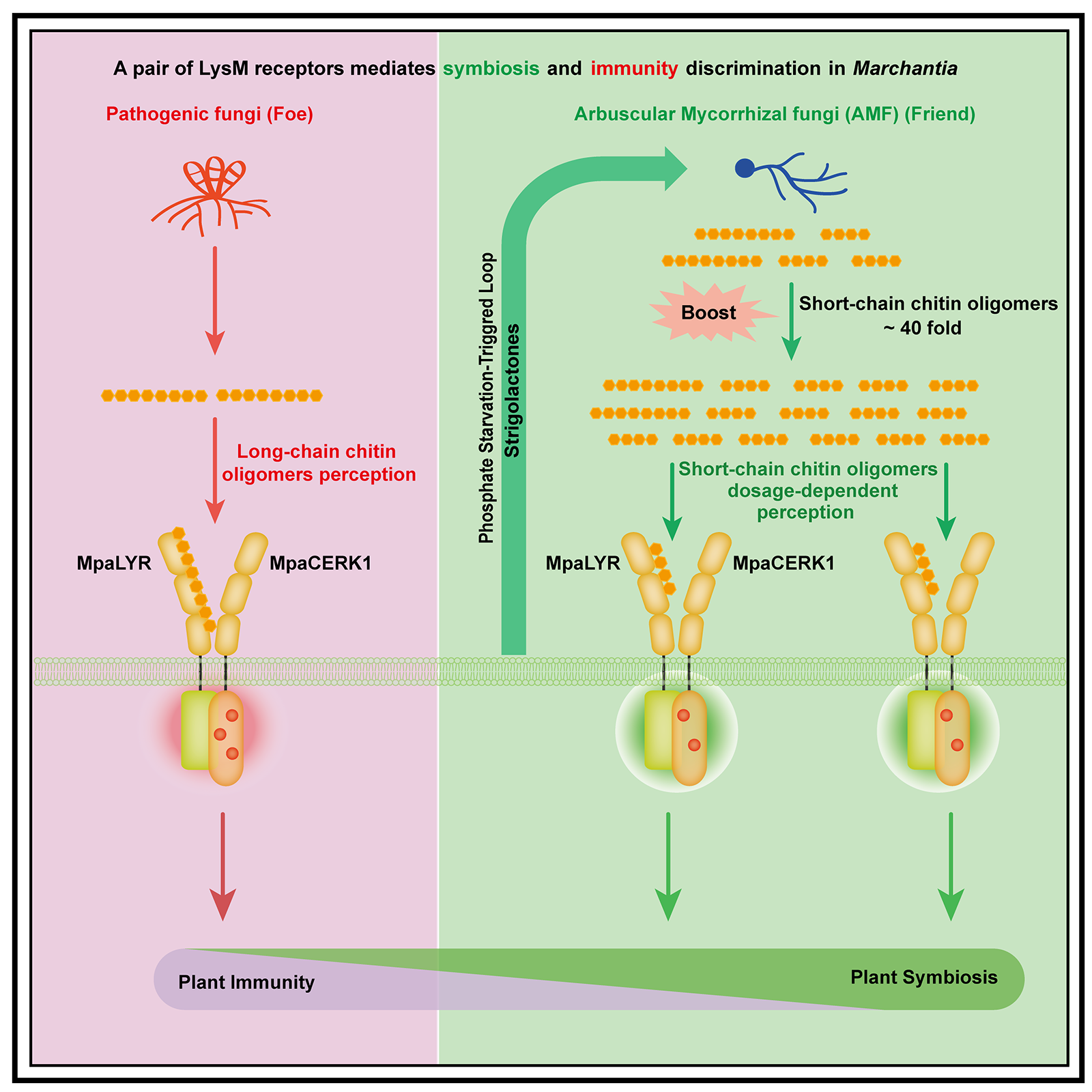How Do Plants Discriminate Symbiotic and Pathogenic Microbes?
The soil surrounding plant roots hosts a diverse range of microbes, including symbiotic microorganisms that form mutually relationships with plants and pathogenic microorganisms that invade plants and deplete their nutrients. Among these, arbuscular mycorrhizal fungi can establish symbioses with most terrestrial plants, enabling them to efficiently absorb essential nutrients such as phosphorus and nitrogen from the soil. Conversely, pathogenic microbes pose a constant threat to plant health and crop yields. Understanding how plants accurately discriminate between symbiotic and pathogenic microbes has become a central scientific question in the fields of plant-microbe interactions and crop science. Addressing this question is critical for advancing research on crop disease prevention and nutrient use efficiency, contributing to national food security.
Previous studies by Professor Ertao Wang’s team at the CAS Center for Excellence in Molecular Plant Sciences, revealed that LysM receptor kinases on plant cell membranes can detect molecular signals from either beneficial symbiotic microorganisms or harmful pathogens, triggering corresponding physiological responses such as symbiosis or immunity (2015 Plant Journal; 2017 Molecular Plant; 2019 Molecular Plant; 2021 PNAS; 2024 New Crops; 2024 Nature). However, the large number of LysM receptor kinases in flowering plants and their overlapping biological functions present challenges in elucidating the mechanisms by which plants precisely distinguish between microbes. Fortunately, the genome of the early land plant Marchantia paleacea is relatively simple and contains fewer LysM receptors, making it an ideal model for studying this question.
On January 24, 2025, Professor Ertao Wang’s team announced significant progress in elucidating the molecular mechanisms behind plant discrimination between symbiotic and pathogenic microbes. The findings were published in the top academic journal Cell under the title “A pair of LysM receptors mediates symbiosis and immunity discrimination in Marchantia”. This study established a molecular framework for plants to specifically recognize symbiotic and pathogenic microbes.
The research identified a single pair of LysM receptor kinases in M. paleacea: MpaLYR and MpaCERK1, that can distinguish between symbiotic and pathogenic microbes and activate distinct downstream signaling pathways. MpaLYR is responsible for recognizing microbial signals. It can bind to short-chain chitin oligomers (CO4/5) from symbiotic microbes as well as long-chain chitin oligomers (CO7/8) from fungal cell wall. Through forming a receptor complex with MpaCERK1, these molecules activate either symbiotic or immune signaling pathways. Importantly, MpaLYR exhibits higher affinity for CO7/8, enabling plants to detect potential pathogenic threats effectively.
The study further revealed that under low-phosphorus conditions, plants release a hormone called strigolactone, which induces mycorrhizal fungi to secrete large quantities of short-chain chitin oligomers (CO4/5). These molecules are recognized by MpaLYR, triggering symbiotic responses while suppressing the immune response induced by CO7/8 from pathogenic fungi. This dynamic balance between symbiosis and immunity allows plants to adapt to diverse terrestrial environments, ensuring nutrient acquisition through mycorrhizal symbiosis while maintaining effective defense against pathogens.
This research deepens our understanding of plant-microbe interaction mechanisms, revealing how plants optimized LysM receptor functions during early terrestrial colonization to form efficient symbiotic relationships with mycorrhizal fungi, enhance nutrient and water absorption, and effectively resist pathogen invasion. It also provides important insights for agricultural practices: Improved Nutrient Use Efficiency: Enhancing plant-mycorrhizal interactions can significantly improve nutrient uptake, particularly in low-fertility soils.
Professor Ertao Wang from the CAS Center for Excellence in Molecular Plant Sciences is the corresponding author of the article. Doctoral student Xinhang Tan and postdoctoral researcher Dapeng Wang are co-first authors. Over the years, Professor Wang’s team has focused on innovative research into plant-microbe symbiosis mechanisms and applications, achieving remarkable progress in the field. Their work not only sheds light on the molecular mechanisms by which plants differentiate between symbiotic and pathogenic microbes but also lays a solid foundation for improving crop nutrient acquisition through microbial interactions. This research was supported by the National Natural Science Foundation of China, the Strategic Priority Research Program of the Chinese Academy of Sciences, and the New Cornerstone Science Foundation.

MpaLYR-MpaCERK1 mediated dosage-dependent perceptions of chitin oligomers sufficiently differentiate the symbiotic and pathogenic microbes

Marchantia paleacea, image source: Plant Photo Bank of China, PPBC